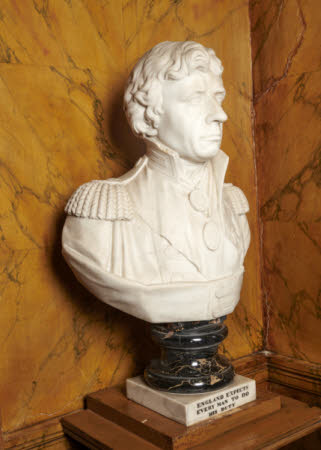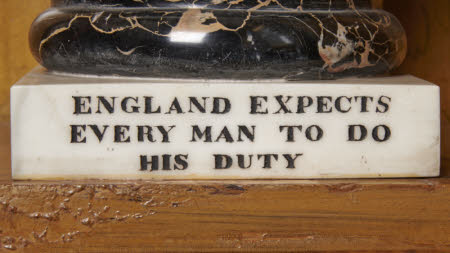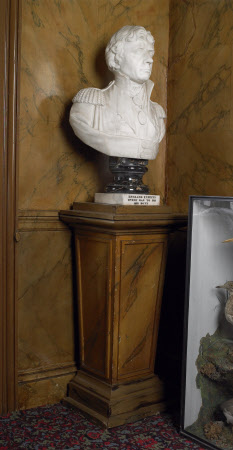Portrait bust of Horatio Nelson, 1st Viscount Nelson (1758-1805)
Thomas Kirk RHA (Cork 1781 - Dublin 1845)
Category
Art / Sculpture
Date
1822
Materials
Marble, nero portoro
Measurements
774 mm (Height); 482 mm (L)
Place of origin
Dublin
Order this imageCollection
The Argory, County Armagh
NT 565241
Summary
Sculpture, marble; Portrait bust of Horatio Nelson, 1st Viscount Nelson (1758-1805); Thomas Kirk (Cork 1781 - Dublin 1845); 1822. A marble portrait bust of the British admiral and hero of the Battle of Trafalgar, the engagement in which Nelson lost his life. This is one of numerous sculpted portraits made in the years following his death, to meet public demand. The sculptor of this bust, Thomas Kirk, made what was once one of the most important sculpted monuments in Ireland, the statue of Viscount Nelson which stood atop a Doric column on Sackville Street (now O’Connell Street) in Dublin, until its destruction by a bomb in 1966.
Full description
A marble bust of Horatio Nelson, First Viscount Nelson (1758-1805) by Thomas Kirk, RHA (1781-1845). The subject is depicted in admiral’s uniform, looking slightly to his left, with his empty right sleeve pinned across the front. He wears the sash, riband and star of the Order of the Bath with the Order’s motto ‘Tria juncta in uno’ (‘Three are joined into one’), and two other decorations: the Order of Saint Ferdinand and Merit, with its motto ‘Pro fide et merito’ (For faith and for merit’), and the Order of the Crescent, with a crescent moon and a star. The bust is signed and dated on the edge of the left shoulder. It is mounted on a black Portoro marble socle and square white marble base, inscribed ‘ENGLAND EXPECTS/EVERY MAN TO DO/HIS DUTY.’ Innumerable portraits of Admiral Nelson were made, during his lifetime in the wake of his famous victories, but then especially following Nelson’s heroic death on 21 October 1805, at the moment of victory in the Battle of Trafalgar (for Nelson’s portraits, see Walker 1998). The Cork-born sculptor Thomas Kirk's first public commission, which established his reputation, was for a sculpture of Viscount Nelson, the statue that stood atop a column in Dublin’s main street, O’Connell Street (formerly Sackville Street), until its destruction in 1966 (Murphy 2010, pp. 16-17, fig. 13). Kirk had the most important sculpture practice in Ireland during the first half of the nineteenth century (Murphy 2010, pp. 52-57; Murphy 2014, pp. 205-07). Unlike other successful Irish-born sculptors such as John Henry Foley, however, Kirk opted not to move to London to further his career, but remained in Dublin, where he made a number of patriotic commissions for Anglo-Irish patrons. Kirk was especially noted for his ability to capture the likenesses of his sitters, as a visitor to his studio in 1822 noted (Freeman’s Journal, 22 November 1822). The bust closely follows other sculpted portraits of Nelson, many of which follow a standard type, with the subject in his dress uniform, his empty right sleeve folded across in front, and wearing various decorations. Such portraits include John Flaxman’s bust of 1805 in the National Maritime Museum, Greenwich, described by Nelson’s niece Charlotte as ‘the only true likeness that has ever been made of my dear uncle’ (van der Merwe 1995, p. 143; Walker 1998, pp. 174-76, 266, no. 215), and the very similar bust made in 1801 by Matthias Ranson (active c.1800–1801) and Franz Thaller (1759–1817), prime versions of which are in the Government Art Collection and the National Maritime Museum, but which was widely disseminated in the form of copies in plaster and other materials (Walker 1998, pp. 102, 107, 235, no.107). It is likely that Kirk used one of these copies as the basis for his portrait. No detailed images of the destroyed statue of Nelson for the Dublin Nelson Monument survive, so it is not possible to know how closely the bust at the Argory followed it, although this would seem quite likely. The decorations worn by Nelson in Kirk’s portrait are some of those that the admiral regarded most highly. The Order of the Bath was awarded to Nelson by King George III in February 1797, following his important contribution to victory at the Battle of Cape Saint Vincent, the engagement in which Nelson lost his right arm. The motto ‘Tria juncta in uno’ signifies the unity of England, Scotland and Ireland, but also refers to the Holy Trinity. The Imperial Order of the Ottoman Crescent was instituted by the Ottoman Emperor Selim III, in order to commemorate Nelson’s defeat of the French at the Battle of Nile in 1798, and was awarded to the admiral in 1799. The Order should be worn with the star to the left of the crescent, but Nelson is here and in other portraits shown wearing it upside down. The Grand Cross of Saint Ferdinand and Merit was presented to Nelson in May 1800 by King Ferdinand IV of Naples and the Two Sicilies, following the restoration to him of his kingdom after French occupation. Another bust of Lord Nelson by Kirk was recorded as in the collection of the Bank of Ireland (Strickland 1913, I, p. 591). Jeremy Warren September 2022
Provenance
By descent to Walter McGeough Bond (1908-86), by whom given to the National Trust in 1979.
Marks and inscriptions
On base: ENGLAND EXPECTS/ EVERY MAN TO DO/ HIS DUTY On left shoulder: T KIRK sculp. DUBLIN 1822
Makers and roles
Thomas Kirk RHA (Cork 1781 - Dublin 1845), sculptor
References
Strickland 1913: W. G. Strickland, Dictionary of Irish Artists, 2 vols.1913 Van der Merwe 1995: Pieter van der Merwe, ed., Nelson. An Illustrated History, London 1995 Walker 1998: Richard Walker, The Nelson Portraits, Portsmouth 1998 Murphy 2010: Paula Murphy, Nineteenth-Century Irish Sculpture. Native Genius Reaffirmed, New Haven/London 2010 Murphy 2014: Paula Murphy, ed., Art and Architecture of Ireland. III. Sculpture 1600-2000, Dublin/New Haven/London 2014




